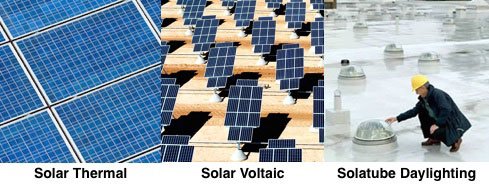When sunlight is used to pre-heat water for domestic use or for warming a pool, there’s no doubt that it’s a renewable energy system. Normally, that water would be heated by gas or electricity. Sure, the conversion from light to heat is only around 50% efficient, but it’s a great system.

When solar energy is converted to electricity by solar voltaic panels and stored in batteries or transferred to the power grid, that’s renewable energy generation, too. Sure, most of today’s solar panels are less than 20% efficient, but free electricity is nothing to sneeze at.
Of course, some of the electricity generated by solar voltaic systems is used for lighting. Here’s a very realistic example:
- 15% efficient solar panels convert some of the sun’s energy into electricity.
- If it’s transferred to the grid, then around 10% is lost in transit.
- If it’s stored in a battery, then at least 15% is lost.
- Once it makes it to your light fixture, only a fraction of the electricity is converted into light, and the rest is wasted as heat. It will even add to your cooling load during the summer, costing energy.
If you use sunlight instead of electric light to illuminate your home or place of business, then you are using solar power at 100% efficiency. Nothing is lost. Now, that’s a renewable energy system!
Not Just a Window
You may be thinking ‘that’s all well and good, but why not just pull back the curtains and let light in through the windows? What’s the difference?’
Everyone knows that windows are no substitute for light fixtures, even during the day. The light they provide is always at the edge of exterior rooms, fading as it spreads to the interior. It doesn’t benefit closed interior spaces at all. Windows provide natural solar lighting and a house with plenty of large windows can be absolutely beautiful. However, windows have three disadvantages: the light from them is difficult to control, they are poor insulators and they invite solar gain.
Even with shades and curtains, there can be problems with glare from windows. During the summer, they’re responsible for solar gain: heat from the sun enters the house through the windows and then becomes trapped, increasing the cooling load. In the winter, they do a poor job of insulating. Heat escapes through diffusion and often through air leakage, as well. Even double and triple-glazed windows are terrible insulators compared to well constructed walls.
Solatube’s skylights are a great way to supplement the windows your home already has, and they have almost none of the disadvantages. Especially if you opt for our Solatube smart LED system, they function more like light fixtures than windows, while using little or no electricity.
Solatube makes tubular skylights that operate like light fixtures. Their walls are made out of a material that reflects 99.7% of the light that hits them. They draw light in at the roof through a convex collector, and they can transport in to anywhere in the house, up to 30 feet from the light collector. That means that in most houses, these tubular skylights can serve interior rooms on the lower storeys.
That’s all well and good in the middle of the day, but what about when it’s dark outside? Our Solatube Smart LED supplements the natural light with high efficiency LED bulbs controlled by a light metre and optional occupancy sensor. When the natural light fades, the LEDs take over.
In effect, we are offering an alternative to standard light fixtures. There’s no better way to utilise solar energy then to use it directly, for lighting. Yes, a skylight can be a renewable energy system.


Hi there, is it possible to shut off the Solatube skylight so no light comes through it, e.g. early morning in the middle of summer?
Hi Nigel,
There is an option of a solar powered daylight dimmer system that allows you to open and close to control the amount of light. https://solatube.com.au/blog/harnessing-the-power-of-the-sun-to-control-daylight/